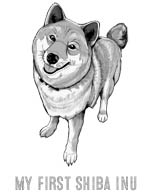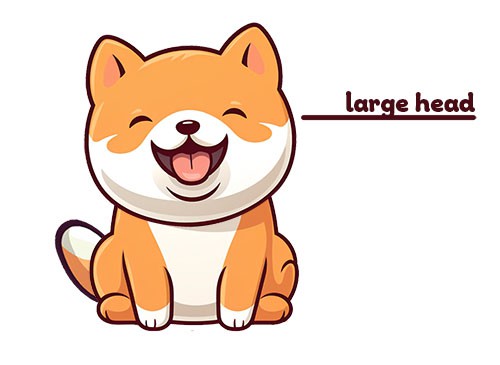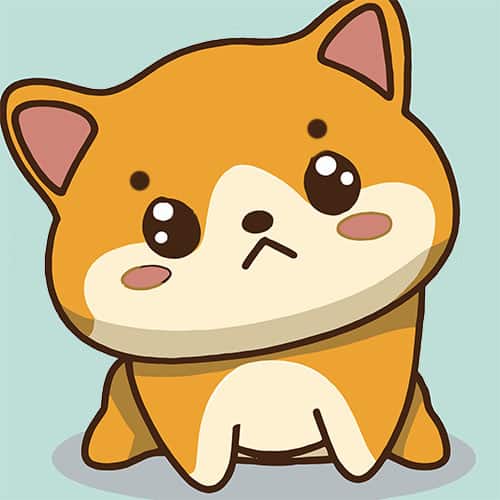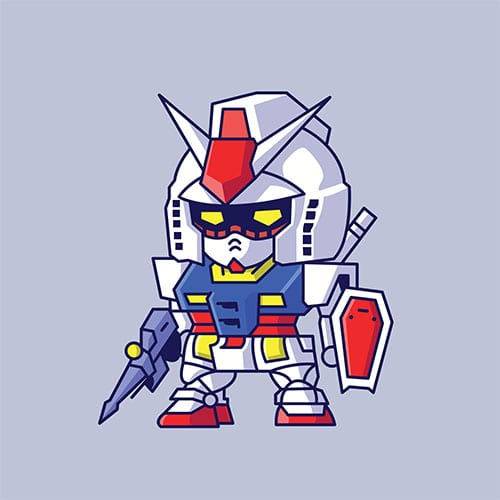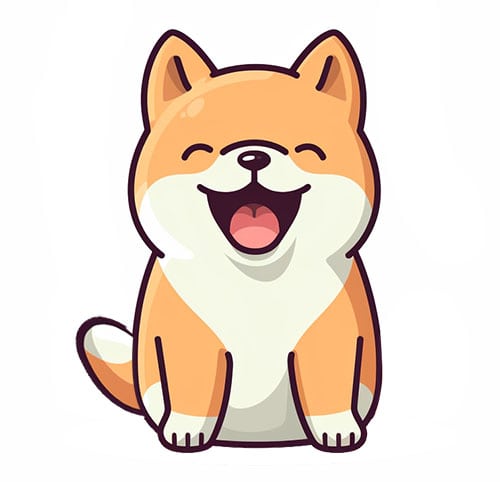On occasion, our posts contain affiliate links. However, we only recommend products that we truly believe in. For more information, visit my privacy policy page.
Shiba Inu Chibi?
That sounds pretty cool, most definitely cute…
Is it a new kind of Shiba Inu? Or is it something else? Let’s learn about what chibi means and how it applies to Shiba Inu.
What Is The Meaning of Shiba Inu Chibi??
To begin, a chibi Shiba Inu is not a living dog, though some Shiba Inu do indeed look like a chibi when pulling on their leash.
No, chibi is a specific art style from Japan that can also be used as an adjective to describe things.
Typically, when you see a chibi Shiba Inu, it is in the form of an illustration, featuring a dog with a head that is slightly too large for its body.
A typical Shiba Inu chibi character has large, exaggerated head compared to smaller body
What is the Difference Between Chibi and Kawaii?
The main difference between chibi and kawaii is that, while both can mean cute, chibi does not necessarily mean “cute” all of the time.
When you call something kawaii, you mean it is cute, adorable, innocent, and in some cases, disarming.
Chibi, on the other hand, is more like calling someone or something a munchkin or a small fry.
As with many things in the Japanese language, chibi is a nuanced and layered term.
Can Chibi Be an Offensive Slang?
Yes, chibi can be offensive.
In order to understand why chibi is sometimes offensive, you need to understand where the word comes from.
Chibi comes from the word tsubu (粒), meaning round, tiny thing, like a granule. If you hear “tsubu tsubu (つぶつぶ), that’s often a description of something bumpy.
Later, as language evolved, the noun tsubu gained a verb that was used to describe something getting rounded and smoothed out.
However, said verb soon became read as chibiru (禿げる), meaning to be worn down.
For many years, the word chibiru was used as a verb or as a compound with a noun.
People only started using chibi on its own during World War II as a way to describe small and short things.
Now, you may be thinking, “That’s not offensive.” Well, hold on a second. There’s more to this history lesson.
The word chibi really took off during the 1980s and 1990s when mini characters were used for humor in magazines and manga.
In fact, in 1984, when SD Gundam was released, it was all thanks to a student who drew deformed Gundam and sent in his ideas to Bandai.
Thus, we got the term SD, meaning “super deformed.” Not too long after, people started using “chibi-kyara,” or “mini characters” to describe the art style.
It’s interesting how Chibi characters has roots in the SD Gundam history!
In other words, chibi and “super deformed” are sometimes used synonymously, and that has led to chibi also having a slightly offensive connotation depending on how you say it to a person.
Can you call your puppy “chibi”?
Yes, all dogs go through that apple-headed SD stage when growing up. A person, however, may likely their feelings hurt – especially if they were born and raised in Japan.
Best Places to Find Chibi Shiba Inu
If you are looking for chibi Shiba Inu artwork, clothes, stationery, or other items, the best places include Amazon, Etsy, Redbubble, and Society 6.
For images, consider Pinterest.
Google can direct you to a number of sites where you can chibi Shiba Inu when looking through the image results.
Learn How to Draw Your Own Chibi Shiba Inu
If you can’t find what you are looking for online, why not try drawing your own chibi Shiba Inu?
Drawing in a chibi style does not require a lot of artistic prowess. Follow these steps:
- Draw two circles. They don’t have to be perfectly symmetrical. Put one circle on top of the other or side by side, depending on how you want your Shiba Inu to be.
- Using the circles as guidelines, draw the head and body. The head should fill almost the entire first circle.
- Add the eyes, ears, nose, and mouth!
- Draw the details of the body, like the paws and tail.
- Add some color to bring your shiba inu to life.
If you want to try another method, this video provides a quick and easy tutorial to follow:
Final Thoughts on Chibi Shiba Inu
To put it simply, a “chibi Shiba Inu” isn’t some new breed of dog; it’s a cute artistic style originating from Japan.
Think big-headed, adorably exaggerated illustrations of these already adorable pups.
But be careful how you use it because this term can sometimes carry a slightly offensive vibe, especially when directed at people!
Thanks for visiting Myfirstshiba.com! We do our very best in providing our readers with awesome content about our beloved Shiba Inu breed. Some of our articles include reviews and recommendations to our favorite products. We do occasionally earn commissions from certain affiliate links that help support our work and mission. Thanks again for visiting. Shiba Kisses To All!
